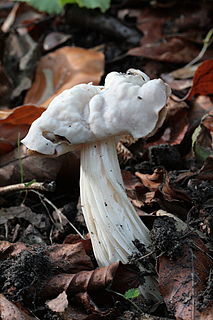
Helvella crispa, also known as the white saddle, elfin saddle or common helvel, is an ascomycete fungus of the family Helvellaceae. The mushroom is readily identified by its irregularly shaped whitish cap, fluted stem, and fuzzy undersurfaces. It is found in eastern North America and in Europe, near deciduous trees in summer and autumn.
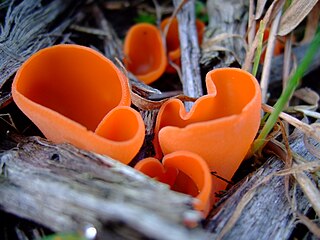
Pezizomycetes are a class of fungi within the division Ascomycota.

Gyromitra is a genus of about 18 species of ascomycete fungi.

Gyromitra infula, commonly known as the hooded false morel or the elfin saddle, is a fungus in the family Helvellaceae. The dark reddish-brown caps of the fruit bodies develop a characteristic saddle-shape in maturity, and the ends of both saddle lobes are drawn out to sharp tips that project above the level of the fruit body. The stipe is white or flushed pale brown, smooth on the outside, but hollow with some chambers inside. It is found in the Northern Hemisphere, usually in the late summer and autumn, growing on rotting wood or on hard packed ground. G. infula is considered inedible as it contains the toxic compound gyromitrin which, when metabolized by the body, is converted into monomethylhydrazine, a component of some rocket fuels. The toxin may be removed by thorough cooking. Gyromitra fungi are included in the informal category "false morels".

Helvella is a genus of ascomycete fungus of the family Helvellaceae. The mushrooms, commonly known as elfin saddles, are identified by their irregularly shaped caps, fluted stems, and fuzzy undersurfaces. They are found in North America and in Europe. Well known species include the whitish H. crispa and the grey H. lacunosa. They have been reported to cause gastrointestinal symptoms when eaten raw.

The Helvellaceae are a family of ascomycete fungi, the best-known members of which are the elfin saddles of the genus Helvella. Originally erected by Elias Magnus Fries in 1823 as Elvellacei, it contained many genera. Several of these, such as Gyromitra and Discina, have been found to be more distantly related in a molecular study of ribosomal DNA by mycologist Kerry O'Donnell in 1997, leaving a much smaller core clade now redefined as Helvellaceae. Instead, this narrowly defined group is most closely related to the true truffles of the Tuberaceae. Although the Dictionary of the Fungi considered the Helvellaceae to contain six genera and 63 species, genetic analysis has shown that Leucangium, previously classified in this family, is more closely related to the Morchellaceae.
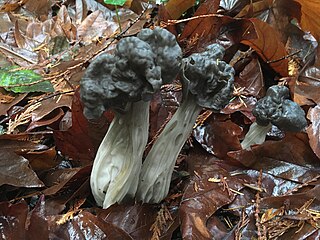
Helvella lacunosa, known as the slate grey saddle or fluted black elfin saddle in North America, simply as the elfin saddle in Britain, is an ascomycete fungus of the family Helvellaceae. It is one of the most common species in the genus Helvella. The mushroom is readily identified by its irregularly shaped grey cap, fluted stem, and fuzzy undersurfaces. It is usually found in Eastern North America and in Europe, near deciduous and coniferous trees in summer and autumn.

Helvella acetabulum is a species of fungus in the family Helvellaceae, order Pezizales. This relatively large cup-shaped fungus is characterized by a tan fruit body with prominent branching ribs resembling a cabbage leaf; for this reason it is commonly known as the cabbage leaf Helvella. Other colloquial names include the vinegar cup and the brown ribbed elfin cup. The fruit bodies reaches dimensions of 8 cm (3.1 in) by 4 cm (1.6 in) tall. It is found in Asia, Europe, and North America, where it grows in sandy soils, under both coniferous and deciduous trees.
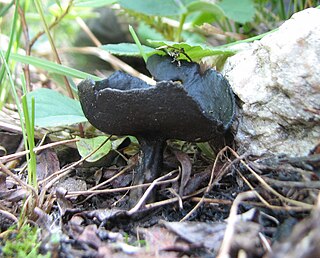
Helvella corium is a species of fungus in the family Helvellaceae of the order Pezizales. This inedible cup-shaped fungus is black, and grows on the ground often near willows in deciduous or mixed forests. Although it has a fairly wide distribution, it is uncommon.
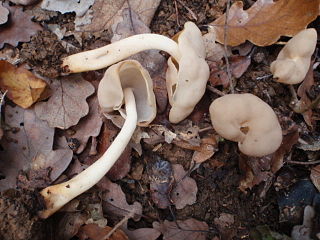
Helvella elastica, commonly known as the flexible Helvella, or the elastic saddle, is a species of fungi in the family Helvellaceae of the order Pezizales. It is found in Asia, Europe, and North America. It has a roughly saddle-shaped yellow-brown cap atop a whitish stipe, and grows on soil in woods. Another colloquial name is the brown elfin saddle.

Helvella leucomelaena, commonly known as the "white-footed elf cup", is a species of fungi in the family Helvellaceae of the order Pezizales. As its common name implies, it is characterized by the white coloring of its stem.

Helvella queletii is a species of fungi in the family Helvellaceae of the order Pezizales.

Helvella latispora is a species of fungi in the family Helvellaceae of the order Pezizales. Ascocarps appear in late summer and autumn as pale stems up to 5 cm in height topped by a greyish saddle shaped cap.
Helvella fibrosa is a species of fungi in the family Helvellaceae of the order Pezizales. It was formerly known as Octospora villosa, originally described by Hedwig in 1789, and was placed in a number of different gerena throughout the decades, including Peziza, Fuckelina, and Cyathipodia. H. fibrosa has also been incorrectly named H. villosa, H. chinensis, and H. dissingii. The current species name was proposed by Richard Korf in 2008.

Helvella ephippium is a species of fungi in the family Helvellaceae, Pezizales order. It appears in summer and autumn as an upright white stem up to 5 cm (2.0 in) tall supporting a greyish-brown saddle-shaped cap. It is found in woodland and is variously listed as inedible or "edible but uninspiring"

Wynnella is a genus of ascomycete fungi of the family Helvellaceae. It contains two species, the type, W. auricula, and W. silvicola. The genus was circumscribed by French mycologist Jean Louis Émile Boudier in 1885. Wynnella is a sister genus to Helvella.

Helvella vespertina is a species of fungus in the family Helvellaceae. It is found in Western North America under conifers. Some specimens have a white moldy appearance, having been colonised by the parasitic Ascomycete fungus Hypomyces cervinigenus.
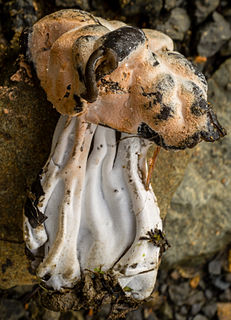
Hypomyces cervinigenus is a parasitic ascomycete fungus that grows on elfin saddle (Helvella) mushrooms in Europe and North America. It was described as new to science in 1971 by Clark Rogerson and Horace Simms. The type collection was made in Pierce County, Washington, where the fungus was found growing on the stipe and cap of what they identified as a fruit body of Helvella lacunosa; later molecular work demonstrated that the European H. lacunosa is not found in North America, and that the North American versions are in fact two similar species, H. vespertina and H. dryophila. H. cervinigenus has perithecia that are white to pale buff with a waxy texture. The ascospores are two-celled, smooth-walled, and measure less than 25 µm long. The anamorph form of the fungus is known as Mycogone cervina.

Helvella albella is a species of fungi in the family Helvellaceae that is found in Europe and North America. It was described by French mycologist Lucien Quélet in 1896.
Helvella semiobruta is a species of fungus in the family Helvellaceae. Originally found in the country of France, it was described as new to science in 1976. It has also been collected in Greece, and Cyprus, where it grows in maquis shrubland.

















